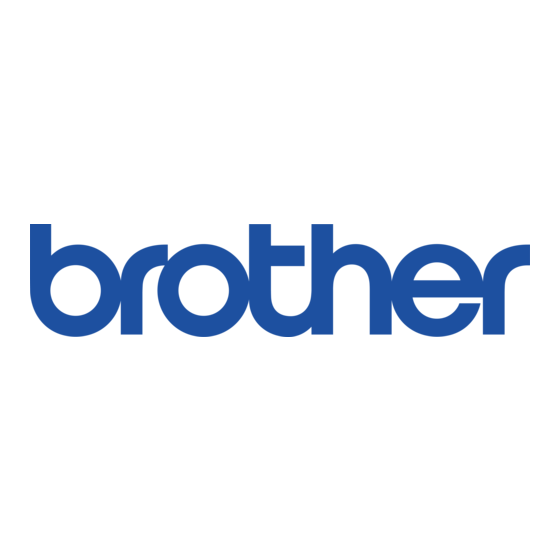Brother DSmobile 820W Podręcznik szybkiej konfiguracji - Strona 6
Przeglądaj online lub pobierz pdf Podręcznik szybkiej konfiguracji dla Skaner Brother DSmobile 820W. Brother DSmobile 820W 6 stron.
Również dla Brother DSmobile 820W: Podręcznik szybkiej konfiguracji (6 strony)

ATTENTION:
The Li-ion battery you have purchased is
recyclable. At the end of its useful life, under various
state and local laws, it is illegal to dispose of this
battery into your municipal waste stream. Please
call 1-800-8-BATTERY
Rechargeable Li-ion battery
• At the time of purchase, the rechargeable Li-ion battery is slightly
charged so that the operation of the scanner can be verified; however,
the rechargeable Li-ion battery should be fully charged via the USB port
before the scanner is used.
• If the scanner will not be used for a long period of time, remove the
rechargeable Li-ion battery from the scanner, and then store it in a
location where it is not exposed to static electricity, high humidity, or
high temperatures (temperatures between 59°F/15°C and 77°F/25°C
and 40% to 60% humidity are recommended). In order to maintain the
efficiency and life of the Li-ion rechargeable battery, charge it at least
every six months.
• If you notice anything unusual about the rechargeable Li-ion battery the
first time it is used, for example overheating or rust, DO NOT continue
to use the battery. Contact Brother customer service.
Tips on using the rechargeable Li-ion
battery
• Charge the rechargeable Li-ion battery before use. Do not use it before
it is charged.
• The rechargeable Li-ion battery charging can take place in 41°F-95°F
(5°C-35°C) environments. Charge the rechargeable Li-ion battery in an
environment in this temperature range. If the surrounding temperature
is out of this range, the rechargeable Li-ion battery will not be charged,
and the battery indicator will remain lit.
• If the scanner is used when both the rechargeable Li-ion battery is
installed and the scanner is connected to your computer, the battery
indicator may turn off and charging may stop even if the rechargeable
Li-ion battery has not been fully charged.
Rechargeable Li-ion battery
characteristics
Understanding the properties of the rechargeable Li-ion battery will allow you
to optimize its usage.
• Using or storing the rechargeable Li-ion battery in a location exposed
to high or low temperatures may accelerate its deterioration. In
particular, using a rechargeable Li-ion battery with a high charge (90%
or more) in a location exposed to high temperatures will considerably
accelerate battery deterioration.
• Using the scanner while the rechargeable Li-ion battery is installed and
charging may accelerate the battery's deterioration. If using the
scanner when the rechargeable Li-ion battery is installed, disconnect
the USB cable.
• If the scanner will not be used for longer than one month, remove the
rechargeable Li-ion battery from the scanner when its charge is 50% or
less, and then store the battery in a cool place away from direct
sunlight.
• If the rechargeable Li-ion battery will not be used for a long period of
time, we recommend charging it every 6 months.
• If you touch a part of the scanner while the Li-ion battery is charging,
that part of the scanner may feel warm. This is normal, and the scanner
may be used safely. If the scanner becomes extremely hot, discontinue
use.
www.brotherearth.com
6
Surroundings temperature range
Charge
Standard discharge current 0.36 A
Maximum discharge current 1.7 A
Less than 1 month
Shipped battery
Less than 3 month
Less than 1 year
Charging parameters
Maximum charging voltage
Maximum charging current
Federal Communications Commission
(FCC) Declaration of Conformity
(USA only)
Responsible Party:
Brother International Corporation
200 Crossing Boulevard
Bridgewater, NJ 08807-0911 USA
TEL: (908) 704-1700
declares, that the products
Product Name: DSmobile 820W / DSmobile 920DW
Model Numbers: DS-820W / DS-920DW
comply with Part 15 of the FCC Rules. Operation is subject to the following
two conditions: (1) This device may not cause harmful interference, and (2)
this device must accept any interference received, including interference that
may cause undesired operation.
This equipment has been tested and found to comply with the limits for a
Class B digital device, pursuant to Part 15 of the FCC Rules. These limits are
designed to provide reasonable protection against harmful interference in a
residential installation. This equipment generates, uses, and can radiate
radio frequency energy and, if not installed and used in accordance with the
instructions, may cause harmful interference to radio communications.
However, there is no guarantee that interference will not occur in a particular
installation. If this equipment does cause harmful interference to radio or
television reception, which can be determined by turning the equipment off
and on, the user is encouraged to try to correct the interference by one or
more of the following measures:
Reorient or relocate the receiving antenna.
Increase the separation between the equipment and receiver.
Connect the equipment into an outlet on a circuit different from that to
which the receiver is connected.
Call the dealer or an experienced radio/TV technician for help.
This transmitter must not be co-located or operated in conjunction with
any other antenna or transmitter.
IMPORTANT
•
Changes or modifications not expressly approved by Brother
Industries, Ltd. could void the user's authority to operate the
equipment.
•
A shielded interface cable should be used to ensure compliance
with the limits for a Class B digital device.
The equipment complies with FCC RF radiation exposure limits set forth for
an uncontrolled environment, under 47 CFR 2.1093 paragraph (d)(2).
The equipment has been tested to the FCC exposure requirements (Specific
Absorption Rate).
32 °F – 113 °F
(0 °C – 45 °C)
-4 °F – 140 °F
(-20 °C – 60 °C)
-4 °F – 140 °F
(-20 °C – 60 °C)
-4 °F – 131 °F
(-20 °C – 55 °C)
14 °F – 113 °F
(-10 °C – 45 °C)
32 °F – 77 °F
(0 °C – 25 °C)
4.2 Vdc
1700 mA
